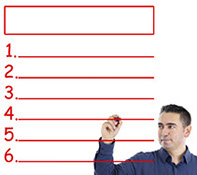feature storIES
HIGHLIGHTS
AOSpine Invites Young Researchers to Get Involved
AOSpine DegenPRO Registry—A Goldmine of Data
Meet AOspine Members
10 tips for
Lecturers
Are you looking to take your lecturing skills to the next level? The following 10 tips will sharpen your presentation and enrich your audience’s experience.
The difference between a good lecture and an excellent one lies in the details. Taking the time to incorporate some of the following tips can give you the boost needed to keep your audience engaged and help them retain more information.

Download Checklist
for Lecture Planning
and Preparation ![]()

Download Checklist
for PowerPoint
Presentations ![]()
 1. LEARNING OUTCOMES & TAKE HOME MESSAGE
1. LEARNING OUTCOMES & TAKE HOME MESSAGE
It is best to stick to no more than three to five major learning points per lecture. Therefore, define a few accessible and easy-to-understand learning outcomes before you start to create your presentation. Make sure that everything in your lecture relates to these learning points. Do not forget to also include a slide with take-home messages at the end of your presentation that reflect the learning outcomes.
 2. DESIGN
2. DESIGN
It is important to keep the presentation design to a basic level and to stick to a consistent layout. Keep in mind that you should make the presentation easy to follow. Use large font sizes and simple fonts. Bullet point lists are always a good idea, but avoid putting more than six lines of six words on a slide. Remember, less is more! You also want to take advantage of visual aids and present figures as diagrams or graphs. (Do not forget to respect your patients' privacy by deleting all patient data in these illustrations).
 3. L = LANGUAGE
3. L = LANGUAGE
Beside your verbal skills, you should also pay attention to your body language. Before you start to present, make sure that you stand relaxed and face towards the audience. During the lecture, communicate with your whole body and use spontaneous gestures to reinforce learning points.
 4. E = EYE CONTACT
4. E = EYE CONTACT
Maintain eye contact throughout your lecture. As soon as you break eye contact for a longer period of time, learners might drift off. A lack of eye contact also gives the impression of anxiety, incompetence, insincerity, and a lack of credibility.

5. C = COMEDY
People like to laugh—but humor needs to be used carefully. Certain types of humor do not translate well into a different language or culture. Having a positive and enthusiastic approach is more valuable than obsessively trying to be funny.
 6. T = TALK
6. T = TALK
Learners need to hear clearly what you say, understand every word, and also have time to reflect. Therefore, keep your pace and tone in check while presenting. You should use short and simple phrases to keep your audience listening.
 7. U = UNEXPECTED
7. U = UNEXPECTED
Create a vivid presentation by providing novelty and variety. A sensational event will be remembered far longer and in more detail than any routine experience.
 8. R = REHEARSAL
8. R = REHEARSAL
Before giving the presentation, you should practice and check the learning environment. Prepare notes with key words and rehearse in front of your family, friends, or even just a mirror. Measure the time of your presentation during the rehearsal, to make sure that you will not overrun your allocated time. At the venue, adjust the lighting and try out the technical equipment to ensure its functionality.
 9. E = ENGAGEMENT
9. E = ENGAGEMENT
Engage the listeners with “interactive” sessions, in which they can participate. Ask questions to ensure understanding or let the audience share their experience or opinion on a certain subject. This ensures attention and active involvement. Also, use visual aids and prompts to illustrate key messages.
 10. R = RESPOND TO THE AUDIENCE
10. R = RESPOND TO THE AUDIENCE
You can always stop your speech and respond to your audience instead. It can also be useful to build in more formal feedback mechanisms, such as questionnaires, show of hands, or an Audience Response System (ARS).
For your better information retention:
Notice that the first letters of tips 3-10 spell the word LECTURER.
Newsletter 20 | March 2019
Newsletter 20
March 2019
Meet AOspine Members